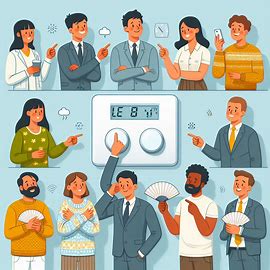Introduction
Setting the Scene
The office thermostat is often a subtle yet powerful presence, influencing employees’ day-to-day comfort and productivity. It controls the micro-environment we spend hours in, making it a focal point of workplace harmony or discord. A properly set thermostat can transform an office into a conducive space for concentration and creativity. However, it often becomes a point of contention as individual preferences vary and external conditions change. Striking the right balance is crucial in ensuring an optimal work environment for all employees.
Importance of Office Temperature
Office temperature plays a critical role in maintaining employee comfort, productivity, and overall well-being. When temperatures are too cold or too hot, it can lead to discomfort, reduced concentration, and increased irritability. Conversely, a well-regulated office temperature fosters an environment where employees can focus and perform at their best. Given that people spend a significant portion of their day at work, achieving an ideal temperature balance is essential for maximizing efficiency and maintaining high levels of employee satisfaction.
Factors Affecting Office Temperature Preferences
Physical Sensitivity
People have different physical sensitivities to temperature due to factors like age, gender, and health conditions. Some individuals may feel colder due to lower body mass or metabolic rates, while others may prefer cooler environments to avoid heat stress. These variances make a single comfortable temperature setting difficult to achieve for everyone in an office. Understanding these physical differences is crucial for employers, as accommodating these needs can significantly influence employee comfort and, by extension, their productivity and overall work satisfaction.
Psychological and Productivity Impacts
Office temperature doesn’t only affect physical comfort; it has significant psychological and productivity implications. An environment that’s too chilly or too warm can be distracting, leading to reduced focus and efficiency. Extended exposure to uncomfortable temperatures can cause stress, impacting mental health and job satisfaction. Furthermore, a persistent, uncomfortable office climate can lead to increased absenteeism and decreased morale among staff. Therefore, achieving an optimal temperature is key to promoting a positive and productive workplace atmosphere for all employees.
Common Thermostat Settings Controversies
Frosty Mornings and Sweltering Afternoons
Throughout the day, external temperatures can vary significantly, complicating the task of maintaining a consistent and comfortable office environment. Mornings may start off chilly, prompting the need for higher thermostat settings, only to transition into sweltering afternoons that require cooler adjustments. This daily temperature fluctuation can make it challenging for office managers to set a thermostat that suits everyone. A dynamic approach, adjusting settings as the day progresses, may be more effective in maintaining a balanced and comfortable workplace atmosphere.
Individual vs. Collective Comfort
Balancing individual comfort with collective needs is a common challenge in office environments. One person’s ideal temperature setting may be too hot or too cold for another, leading to disagreements and discomfort. This disparity requires office managers to find a middle ground that meets the general preferences of the majority while also considering the needs of outliers. Strategies like zoning or personal fans and heaters can help address individual comfort. Ultimately, fostering open communication and compromise is essential for achieving a workable balance.
Strategies for Resolving The Office Thermostat Dilemma
Communication and Compromise
Effective communication is vital in resolving office thermostat disputes. Encouraging employees to voice their preferences and discomforts can help identify common concerns and areas for compromise. Open discussions allow for collaborative decision-making, ensuring that everyone’s opinions are considered. Compromise might involve setting the thermostat to a median temperature or allowing minor adjustments throughout the day. By prioritizing transparent communication and mutual respect, office managers can create a more comfortable and harmonious working environment that accommodates the varying needs of all employees.
Implementing Technology Solutions
Modern technology offers innovative solutions to the office thermostat dilemma. Smart thermostats can automatically adjust settings based on time of day, occupancy, and even external weather conditions, ensuring a consistently comfortable environment. Zoning systems allow for different areas of the office to maintain individual temperatures, catering to diverse preferences. Additionally, personal climate control gadgets, like desk fans or portable heaters, can provide employees with more control over their immediate surroundings. Employing these technologies can significantly enhance comfort and satisfaction in the workplace.
Impact of Office Temperature on Health and Well-being
Health Implications
Office temperature can have notable health implications. Consistently low temperatures may lead to issues like respiratory problems, dry skin, and decreased immune function. Conversely, high temperatures can cause dehydration, heat exhaustion, and discomfort. Moreover, frequent transitions between hot and cold can exacerbate conditions like arthritis or migraines. Ensuring a stable and moderate office temperature is crucial for maintaining physical health and preventing these issues. Employers have a responsibility to create a healthy work environment, which includes paying attention to temperature regulation.
Employee Satisfaction and Retention
Office temperature significantly impacts employee satisfaction and retention. Comfortable working conditions contribute to a positive workplace experience, making employees more likely to stay with the company. Conversely, unresolved temperature issues can lead to dissatisfaction, reduced morale, and higher turnover rates. By prioritizing a comfortable office climate, employers demonstrate their commitment to employee well-being. This commitment can foster loyalty and enhance job satisfaction. In the long run, maintaining an optimal office temperature is a simple yet effective strategy for improving employee retention and creating a supportive work environment.
Conclusion
Achieving Temperature Harmony
Achieving temperature harmony in an office requires a balanced approach that incorporates communication, technology, and flexibility. Regularly soliciting feedback from employees can help gauge the general comfort level and make necessary adjustments. Implementing technologies like smart thermostats and zoning systems can finely tune environmental controls. Additionally, offering employees individual climate control devices can address personal preferences. By combining these strategies, office managers can create a consistently comfortable working environment, ultimately boosting employee satisfaction, productivity, and overall workplace harmony.
The Never-ending Debate: Can We Ever Agree on the Office Thermostat?
The office thermostat debate is unlikely to be resolved entirely, given the diversity of individual preferences and physical sensitivities. Each person has unique comfort levels influenced by various factors, making a universal agreement challenging. However, fostering open communication, promoting compromise, and leveraging modern technology can mitigate much of the conflict. While total consensus may be elusive, strategies that address the majority’s needs, coupled with the flexibility to cater to individual preferences, can ensure a generally comfortable and productive workplace for everyone.





